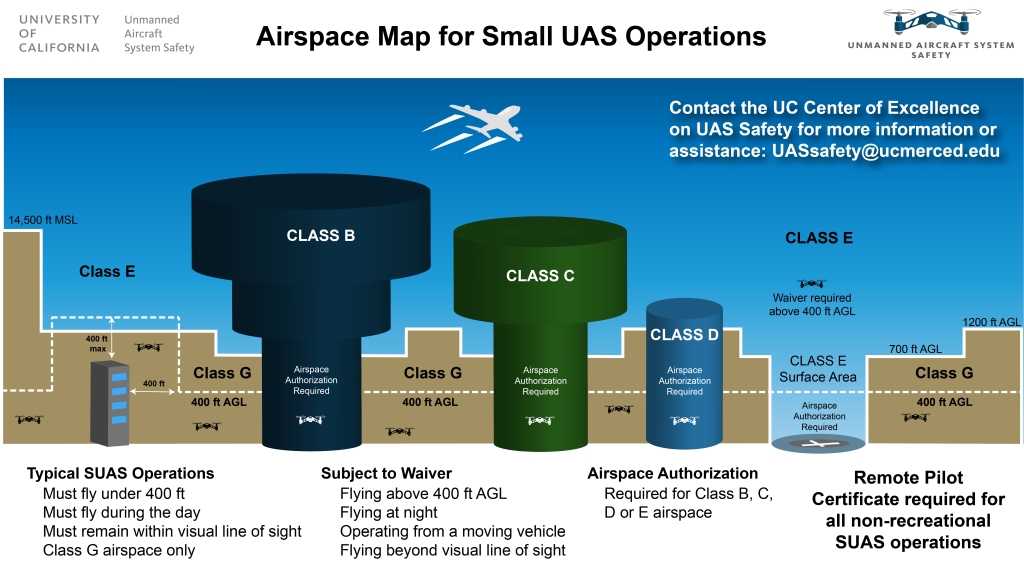3.1 What is Airspace?
The Federal Aviation Administration is in charge of making the rules and regulations for everyone in the United States flying above the ground. While the National Airspace System (NAS) does not have roads or streets like we have on the ground, there are a lot of rules about how to use the airspace correctly for the safety of others1.
3.1.1 Airspace Classes
Since aviation works in 3 dimensions, so do the airspace rules. Figure 3.1 gives a side profile of how the airspace is separated into different Classes.

Figure 3.1: Small UAS Airspace Rules
Class A - Airlines
Class A is not shown in Figure 3.1, but exists way up high between 18,000 ft and 60,000 ft above sea level - this is where commercial airliners fly and where our drones should not be. Flying up this high requires special coordination with Air Traffic Control to guide pilots to their destinations.
Class B - Big Airports
Class B airspace is found around the biggest airports in the country - including LAX and SFO. Every Class B airspace is individually tailored as needed to help guide aircraft around these busy areas. This usually involves 2 or more different sized layers at different altitudes - imagine an aircraft taking off from a runway and staying in Class B airspace until it leaves the busiest areas. Given the amount of air traffic around these airports, no one is allowed to fly in Class B airspace unless Air Traffic Control says its ok.
Class C - Common Airports
Class C airspace is found around some of the more common regional airports, such as the Sacramento or Fresno airports. They’re busy areas, but not nearly as busy as the major airports, and so they don’t need to control as much of the sky as them.
Class D - Dinky Airports
Class D airspace is found around small airports that don’t have a lot of commercial airline traffic, mostly catering to private aviation use, such as the airports in Stockton or Palm Springs. But as with Class B and C airspace, no one is allowed to fly within Class D airspace without permission.
Class E - the Everywhere Airspace
Class E airspace is the other airspace that is not part of Class A, B, C, D or G airspace. Fun fact, there are 7 different classifications of Class E airspace. But as a drone pilot, the most important consideration of Class E airspace is when your in the part of Class E airspace at the surface that is designated for an airport. In that case, you’ll also need to get permission to fly in that airspace.
Class G - The Ground Airspace
Class G airspace is the airspace at the ground - starting from the ground and going up to either 700 ft or 1200 ft above the ground, depending on location. This is the only airspace that drones are allowed to fly in without getting prior permission. This is true even if you’re near an airport. Very small airports, such as those for cropdusters or personal use, do exist in Class G airspace. Though they do not control the airspace near them, you should make sure you stay out of their way.
3.1.2 What do you need to know?
There’s a lot of information to unpack when looking into airspace information. As you try to figure out if your location will be safe, you’ll want to look up:
- Airspace Class
- Nearby Airports, including smaller ones and helipads
- Potential air traffic patterns
- Special Use Airspace - Military Operating Areas, Controlled Firing Ranges, National Security Areas, and Restricted Areas
- Flying altitude limits within certain zones or grids
- Temporary Flight Restrictions or special alerts